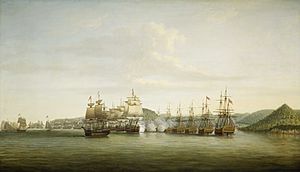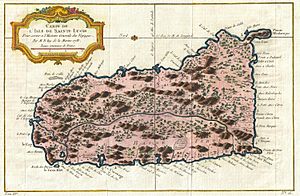History of Saint Lucia facts for kids

Saint Lucia is an island in the Caribbean. Before Europeans arrived in the early 1500s, the island was home to the Arawak and Kalinago Carib people. In the 1600s, both the British and French tried to colonize it. The island changed hands many times between these two countries. Finally, in 1814, France gave Saint Lucia to the British for good.
In 1958, Saint Lucia joined the West Indies Federation, which was a group of Caribbean islands working together. This group did not last long. From 1967 to 1979, Saint Lucia was an "associated state" of the United Kingdom. This meant it managed its own affairs but the UK handled its defense. On February 22, 1979, Saint Lucia became a fully independent country.
Contents
Early History of Saint Lucia
Saint Lucia was first settled by people called the Ciboney people between 1000 and 500 BC. However, we don't have much proof of their time there. The first people we know for sure lived on the island were the peaceful Arawaks. They likely came from northern South America around 200-400 AD. Many old sites on the island show their well-made pottery. These early people might have called the island Iouanalao. This name meant 'Land of the Iguanas', because there were so many iguanas there.
Around 800 AD, the more warlike Caribs arrived. They took control from the Arawaks. They killed the Arawak men and welcomed the women into their own society. The Caribs called the island Hewanarau, and later Hewanorra. This name is now used for the Hewanorra International Airport in Vieux Fort. The Caribs had a well-organized society with kings and spiritual leaders called shamans. Their war canoes were very large, holding over 100 men. They were also very fast. Later, European invaders feared the Caribs because they were fierce fighters.
European Arrivals in the 1500s
The famous explorer Christopher Columbus might have seen Saint Lucia during his fourth trip in 1502. He landed on a nearby island, Martinique, but he didn't write about Saint Lucia in his travel log. However, a map from 1500 by Juan de la Cosa shows the island, calling it El Falcon. Another map from 1529 shows it as S. Luzia. A globe from 1502 in the Vatican also shows the island as Santa Lucia.
In the late 1550s, a French pirate named François le Clerc used Pigeon Island as his base. He was known as Jambe de Bois because he had a wooden leg. From this base, he would attack Spanish ships sailing by.
Battles for Control in the 1600s
In 1605, an English ship called the Oliphe Blossome was blown off course on its way to Guyana. The 67 people on board started a settlement on Saint Lucia. The Carib chief Anthonie first welcomed them. But by September 1605, only 19 people were left due to attacks from another Carib chief, Augraumart. The remaining settlers then left the island.
Both England and France wanted to colonize the Caribbean islands. In 1626, France created a company to settle islands like Saint Lucia. The next year, England's King Charles I gave rights to the same islands to an English earl. This led to many arguments over who owned Saint Lucia.
In 1635, English settlers from Bermuda tried to set up a colony. At the same time, a French letter says a Frenchman named Pierre Belain d'Esnambuc also started a settlement. Later, in 1640, another group of 300-400 Englishmen tried to settle at Praslin Bay. But the Caribs attacked them for three weeks, and the few survivors had to flee.
In 1650, the French, led by Jacques Dyel du Parquet, sent 40 men to build a fort near what is now Castries. Du Parquet bought the rights to Saint Lucia and other islands. The French fought off an English invasion in 1659. However, they let the Dutch build a small fort in 1654.
In 1663, the Caribs sold Saint Lucia to an English governor named Francis Willoughby, 5th Baron Willoughby of Parham. He invaded the island with 1100 Englishmen and 600 Native Americans. They forced the 14 French defenders to leave. But the English colony suffered from disease. The French took over again, but the English returned in 1664. They held the island until 1665, when diplomacy gave it back to the French. The English invaded again in 1665, but disease, hunger, and Carib attacks forced them to flee in 1666. The Treaty of Breda (1667) officially gave the island back to the French. The English raided the island in 1686 but gave up all claims in treaties in 1687 and 1697.
| Date | Country |
|---|---|
| 1674 | French crown colony |
| 1723 | Neutral territory (agreed by Britain and France) |
| 1743 | French colony (Sainte Lucie) |
| 1748 | Neutral territory (de jure agreed by Britain and France) |
| 1756 | French colony (Sainte Lucie) |
| 1762 | British occupation |
| 1763 | Restored to France |
| 1778 | British occupation |
| 1783 | Restored to France |
| 1796 | British occupation |
| 1802 | Restored to France |
| 1803 | British occupation |
| 1814 | British possession confirmed |
The 1700s: Sugar and Revolution
In the 1700s, the sugar industry grew, using enslaved people to work the plantations. Both the British (from Barbados) and the French (from Martinique) wanted Saint Lucia because of this. The island changed hands or was declared neutral many times during this century. However, French settlements remained, and it was largely a French colony.
In 1722, the British King George I of Great Britain gave Saint Lucia to John Montagu, 2nd Duke of Montagu. He sent a captain named Nathaniel Uring to settle the island. But the French quickly drove Uring and his settlers away.
By 1730, Saint Lucia had 463 people. This included 125 white settlers, 37 Caribs, 175 enslaved people, and 126 free black or mixed-race people. The French took full control in 1744. By 1745, the population grew to 3,455, with 2,573 enslaved people.
During the Seven Years' War, Britain took Saint Lucia in 1762. But they gave it back to France in 1763 as part of the Treaty of Paris. Britain took the island again in 1778 during the American Revolutionary War. British Admiral George Rodney then built Fort Rodney between 1779 and 1782.
By 1779, the island's population reached 19,230. This included 16,003 enslaved people working on 44 sugar plantations. However, the Great Hurricane of 1780 killed about 800 people. When the island was given back to French rule in 1784, many plantations were empty. About a thousand maroons (enslaved people who had escaped) lived in the island's interior.
In January 1791, during the French Revolution, France sent people to Saint Lucia to spread the ideas of the revolution. By August, enslaved people started leaving their plantations, and the governor fled. In December 1792, a French officer arrived with revolutionary writings. Poor white people and free people of color began to arm themselves as "patriots." On February 1, 1793, France declared war on England and Holland.
The French government officially ended enslavement on February 4, 1794. But Saint Lucia soon fell to a British invasion in April 1794. The British renamed Morne Fortune to Fort Charlotte. However, a patriot army of resistance, called L'Armee Francaise dans les Bois (The French Army in the Woods), began to fight back. This started the First Brigand War.
In 1795, a group of rebels led by Victor Hugues defeated British troops. For the next four months, recently freed enslaved people, known as the Brigands, drove out the British army and white slave owners. The English were defeated in June and fled the island. The Royalist plantation owners also left. The remaining Saint Lucians enjoyed "l’Année de la Liberté" (the Year of Freedom). Gaspard Goyrand, a Frenchman, became Governor and announced the end of slavery. He put aristocratic planters on trial, and some were executed.
The British still wanted to take back the island. In April 1796, Sir Ralph Abercrombie and his troops tried again. Castries was burned during the fighting. After about a month of fierce battles, the French surrendered on May 25. General Moore became Governor and was left with 5,000 troops to control the island.
British General John Moore was appointed Military Governor in May 1796. He led the Second Brigand War. Some Brigands started to surrender in 1797 when they were promised they would not be returned to slavery. Full freedom for all enslaved people came with the Emancipation Act in 1838.
The 1800s: British Control
The 1802 Treaty of Amiens gave the island back to French control. Napoleon Bonaparte then brought back slavery. But the British took the island again in June 1803. The island was officially given to Britain in 1814.
In 1838, Saint Lucia became part of the British Windward Islands administration. Its main office was in Barbados until 1885, when it moved to Grenada.
Saint Lucia in the 1900s and 2000s

During World War II, a German U-boat (submarine) attacked and sank two British ships in Castries harbor on March 9, 1942.
Saint Lucia slowly gained more self-government in the 1900s. In 1924, a new constitution gave the island its first elected representatives in the government. In 1951, all adults were allowed to vote. In 1956, a system of ministers was introduced. In 1958, Saint Lucia joined the short-lived West Indies Federation, a group of islands that worked together but were still part of the UK. When this federation ended in 1962, Saint Lucia tried a smaller group, but that also failed.
After these attempts, the United Kingdom and six other islands, including Saint Lucia, created a new arrangement called "associated statehood." This meant Saint Lucia was in charge of its own internal government. However, the United Kingdom was still responsible for its foreign affairs and defense.
By 1957, bananas became the main export crop, replacing sugar.
This arrangement ended on February 22, 1979, when Saint Lucia became fully independent. Saint Lucia is a Constitutional Monarchy, meaning it has a king or queen as its head of state, currently King Charles III. It is also an active member of the Commonwealth of Nations. The island works with its neighbors through groups like the Caribbean Community (CARICOM) and the Organisation of Eastern Caribbean States (OECS).
In June 2016, the United Workers Party (UWP), led by Allen Chastanet, won the general election. They took 11 out of 17 seats, replacing the St Lucia Labour Party (SLP). However, the Saint Lucia Labour Party won the next election in July 2021. This made its leader, Philip J. Pierre, the ninth Prime Minister of Saint Lucia since independence.
See also
 In Spanish: Historia de Santa Lucía para niños
In Spanish: Historia de Santa Lucía para niños
- British colonization of the Americas
- French colonization of the Americas
- History of the Americas
- History of the British West Indies
- History of North America
- History of the Caribbean
- List of colonial governors of Saint Lucia
- List of prime ministers of Saint Lucia
- Politics of Saint Lucia
- Spanish colonization of the Americas



